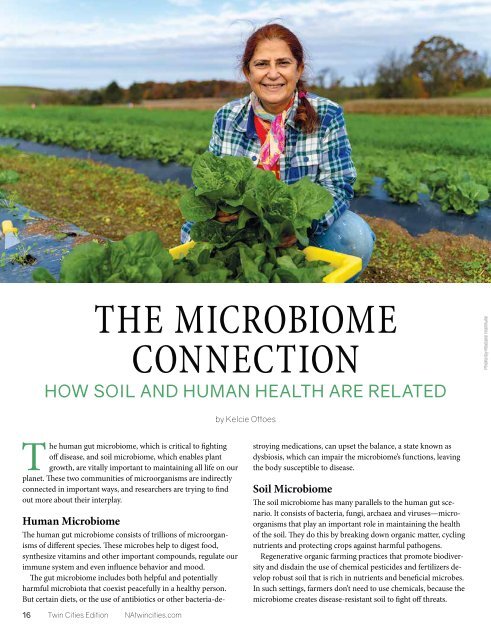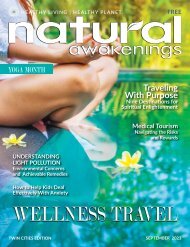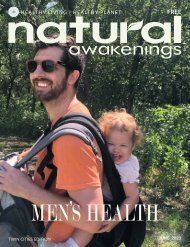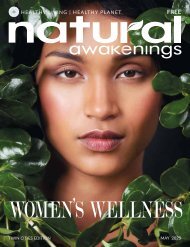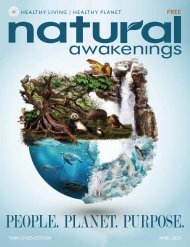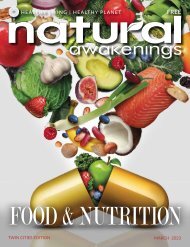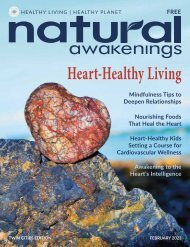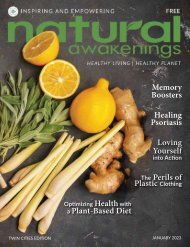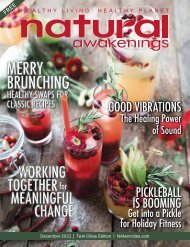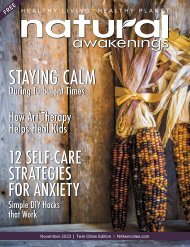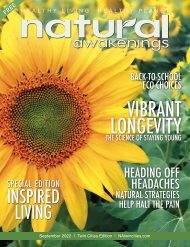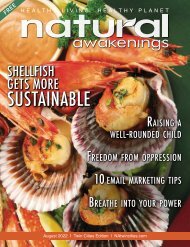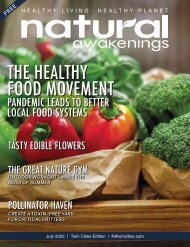Natural Awakenings Twin Cities July 2023
Read the July 2023 edition of Natural Awakenings Twin Cities magazine. This is our annual Food Connection Issue which features articles on eating healthy and minimizing food waste, regenerative techniques for a healthy ecosystem, benefits of a colorful diet, gut health for kids, microbiome connection, fighting climate change in the garden, and so much more! Be sure to check out our local content, including News Brief announcements, Community Resource Guide with providers throughout the metro who can meet your individual wellness needs, and all the happenings in the Calendar of Events. There is additional online-only content that can be found at NATwinCities.com.
Read the July 2023 edition of Natural Awakenings Twin Cities magazine. This is our annual Food Connection Issue which features articles on eating healthy and minimizing food waste, regenerative techniques for a healthy ecosystem, benefits of a colorful diet, gut health for kids, microbiome connection, fighting climate change in the garden, and so much more!
Be sure to check out our local content, including News Brief announcements, Community Resource Guide with providers throughout the metro who can meet your individual wellness needs, and all the happenings in the Calendar of Events. There is additional online-only content that can be found at NATwinCities.com.
You also want an ePaper? Increase the reach of your titles
YUMPU automatically turns print PDFs into web optimized ePapers that Google loves.
THE MICROBIOME<br />
CONNECTION<br />
HOW SOIL AND HUMAN HEALTH ARE RELATED<br />
Photo by Rodale Institute<br />
by Kelcie Ottoes<br />
The human gut microbiome, which is critical to fighting<br />
off disease, and soil microbiome, which enables plant<br />
growth, are vitally important to maintaining all life on our<br />
planet. These two communities of microorganisms are indirectly<br />
connected in important ways, and researchers are trying to find<br />
out more about their interplay.<br />
Human Microbiome<br />
The human gut microbiome consists of trillions of microorganisms<br />
of different species. These microbes help to digest food,<br />
synthesize vitamins and other important compounds, regulate our<br />
immune system and even influence behavior and mood.<br />
The gut microbiome includes both helpful and potentially<br />
harmful microbiota that coexist peacefully in a healthy person.<br />
But certain diets, or the use of antibiotics or other bacteria-de-<br />
stroying medications, can upset the balance, a state known as<br />
dysbiosis, which can impair the microbiome’s functions, leaving<br />
the body susceptible to disease.<br />
Soil Microbiome<br />
The soil microbiome has many parallels to the human gut scenario.<br />
It consists of bacteria, fungi, archaea and viruses—microorganisms<br />
that play an important role in maintaining the health<br />
of the soil. They do this by breaking down organic matter, cycling<br />
nutrients and protecting crops against harmful pathogens.<br />
Regenerative organic farming practices that promote biodiversity<br />
and disdain the use of chemical pesticides and fertilizers develop<br />
robust soil that is rich in nutrients and beneficial microbes.<br />
In such settings, farmers don’t need to use chemicals, because the<br />
microbiome creates disease-resistant soil to fight off threats.<br />
16 <strong>Twin</strong> <strong>Cities</strong> Edition NAtwincities.com


